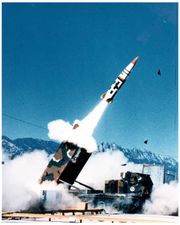 By a vote of 71 to 26, the U.S. Senate Wednesday ratified the New START arms reduction treaty between the United States and Russia that will reduce each nation’s nuclear arsenals to their lowest levels in more than a half century.
By a vote of 71 to 26, the U.S. Senate Wednesday ratified the New START arms reduction treaty between the United States and Russia that will reduce each nation’s nuclear arsenals to their lowest levels in more than a half century.
The New Strategic Arms Reduction Treaty was signed by President Obama and Russian President Dmitry Medvedev on April 8 in Prague.
“This is the most significant arms control agreement in nearly two decades,” Obama said after the Senate vote. “It will make us safer.”
Most importantly, the treaty will help to reset relations with Russia, which have been strained of late. It will once again place inspectors in each country to verify that the terms of the agreement will be met during the treaty’s 10-year timeline.
“This treaty will enhance our leadership to stop the spread of nuclear weapons and seek the peace of the world without them,” Obama said.
The treaty, which replaces the 1991 Strategic Arms Reduction Treaty, required the approval of a two-thirds majority of the Senate, or 67 senators. The treaty now must also win approval in the Russian Duma, but Russian officials said they are ready to ratify the nuclear arms pact. Russia’s lower house of parliament on Friday gave preliminary approval to a U.S.-Russian arms treaty, but decided to delay further moves until next month.
Secretary of State Hillary Rodham Clinton said the Senate’s action was a significant step forward in enhancing U.S. national security.
“A responsible partnership between the world’s two largest nuclear powers that limits our nuclear arsenals while maintaining strategic stability is imperative to promoting global security,” Clinton said shortly after the Senate voted. “With New START, the United States and Russia will have another important element supporting our ‘reset’ relationship and expanding our bilateral cooperation on a wide range of issues.”
Senate Foreign Relations Committee Chairman John Kerry said the treaty is essential for U.S. national security. “The stakes are enormous,” he said. Kerry told the Senate that by ratifying this treaty the United States will redouble international support for nonproliferation efforts.
The treaty limits the United States and Russia to 1,550 strategic nuclear warheads for each country, down from the current limit of 2,000 warheads, and 700 launchers. The treaty also requires on-site verification inspections, which had lapsed in December 2009 when the old START Treaty expired. Russia and the United States possess 90 percent of the world’s nuclear weapons.
New START is designed to succeed the 1991 treaty and the 2002 Moscow Treaty. The treaty does not block efforts to create missile defense systems.
The treaty gives the United States and Russia seven years to reduce forces and remains in force for 10 years from ratification. It contains detailed definitions and counting rules that will help the parties calculate the number of warheads that count under the treaty limits. Additionally, the treaty provides for detailed, regular, on-site inspections of each country’s nuclear arsenals to assure compliance and implementation of the immense technical aspects of nuclear arms reduction programs.
The first START Treaty in 1991 took the number of deployed nuclear weapons down from about 12,000 warheads on each side to about 6,000, then the Moscow Treaty in 2002 reduced that number to a range of 1,700 to 2,000.
For President Obama the treaty is a critical centerpiece to his foreign policy program and reflects his broader world view. He was awarded the 2009 Nobel Peace Prize for his efforts to foster arms control and nuclear nonproliferation efforts worldwide.
(Source: U.S. Department of State – www.america.gov)




















[…] New Strategic Arms Reduction Treaty was signed by President Obama and Russian President Medvedev in Prague, to reduce each nation’s […]